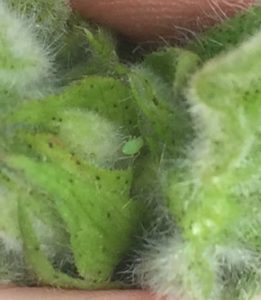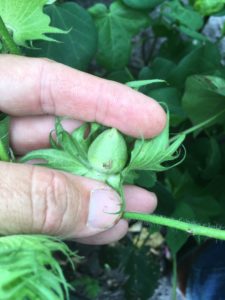Cotton fields range from pinhead square to early bloom. Most fields are susceptible to cotton fleahopper damage and the potential for bollworm losses. We are finding cotton fleahoppers in numbers as high as 1 per plant, averaging around 20-30 per 100 plants.
Continue to scout for cotton fleahoppers through the first week of bloom. This pest may cause fruit shed of small pinhead squares. Squares larger than matchhead size are generally safe from fleahopper damage. Once the plant has reached bloom, 80-90% of the fruit that will be harvested is already on the plant. Thus, we usually do not have yield limiting populations of cotton fleahoppers after bloom.
Scout by visually inspecting plant terminals, the top three nodes, looking for adults and nymphs. The nymphs can be very small, and I have begun using a 2-gallon bucket to beat plants, 2-3 at a time, and looking in the bucket for fleahoppers (especially nymphs). Combining these two methods will increase your confidence in what you are finding.
Use an economic threshold of 15 cotton fleahoppers per 100 plants to determine when treatment is needed.
For the past 20 years we have relied on Bt cotton for control of cotton bollworms. But in the past few years, the levels of worm control from some of the Bt technologies has been declining to a point that additional control has been necessary to prevent economic yield losses.
This week’s rainfall may trigger an egglay and fields should be scouted for worm eggs, small larvae, and feeding damage. I do not suggest treating based on egglay but finding eggs can help you know when to expect to see small worms. Remember the worm has to feed on the plant to get the Bt toxin, so don’t be alarmed if you find small 1/8-inch worms.
But worms larger than 1/4-inch are not being controlled by the Bt.
The cotton bollworm egg will hatch three days after it has been laid. On the first day it will be pearly white, then tan-brown on the second day and darker brown to black on the third day.
Scout fields by looking for terminal feeding and follow the feeding to find the worm. It is also important to look lower in the plant canopy for worms as eggs will often be laid on blooms and small bolls.
Inspect 20-40 plant terminals, squares and small bolls for worm feeding. Recent field studies have looked at treatment thresholds based on worm feeding. An economic threshold of 6-8% square and boll feeding has been found useful in preventing losses.
Once a field has 1-inch bolls, begin to look for stink bug feeding by pulling 1-inch bolls and inspecting the inside for evidence of stink bug or verde plant bug feeding. Check 50 bolls per field from several places in the field. Increase the number of bolls you check if you are finding stink bug feeding until you are confident in the level of feeding.
I have found that bolls without feeding spots on the outside usually do not have internal feeding. So, when popping bolls open I usually separate the bolls based on external spots and save those without spots for last and discard them if the threshold is exceeded before I get to them.



